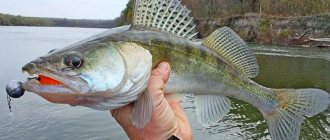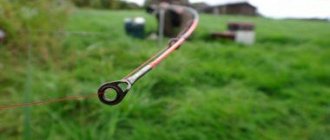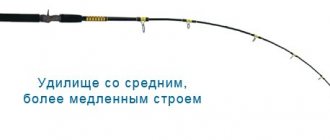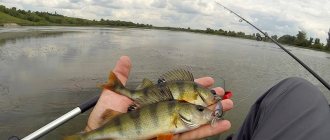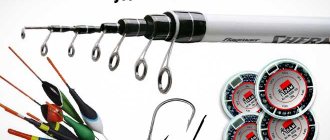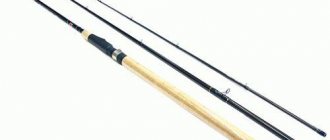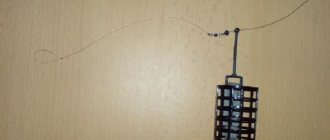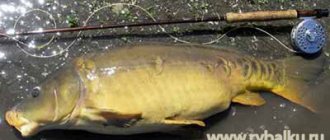Fishing with an onboard rod from a boat is a very productive fishing activity that is accessible to everyone. Most often, its target is bream. But you can catch other fish in this way - ide, crucian carp, carp and so on.
Many people prefer to fish only from the shore. But the results of fishing from a boat are much better. So it wouldn’t hurt for every real fisherman to learn how to use a watercraft. There is nothing complicated in controlling it, as well as in the technique of fishing with onboard tackle.
Advantages of fishing with a side rod
There are many advantages to fishing with a side line that make this type of fishing worth paying attention to.
Using a watercraft, you can stand directly above a promising area, accurately feed it and accurately present the bait.
If when fishing from the shore the fish often have to be dragged several tens of meters, then when fishing from a boat this distance usually does not exceed 10 meters.
Thanks to all this, the chances of good catches are much greater. A side rod is the best tackle for fishing in the deep water where the good fish are holding.
With the help of a boat and an echo sounder, you can quickly examine any areas of the reservoir to find promising ones. When fishing from the shore there is no such opportunity.
A side fishing rod is a compact piece of equipment that easily fits in a backpack. It makes it convenient to travel by public transport to a body of water where you have a boat or where you can rent one.
It is easy to make a side fishing rod with your own hands. It will be quite inexpensive.
Side rods
Various onboard rods are also widely used as tackle for bream from a boat. These are short, very similar to winter fishing rods (often the same rod is used both as a rod and for winter fishing), and are equipped with a hard nod. This type of gear makes it possible to fish from the bottom in almost any conditions - the nod indicates bites in rough weather, in windy weather, and in strong currents. These are relatively short fishing rods (on average their length ranges from 60-80 centimeters to 1 meter), which are sometimes bought in a store, but more often they are made independently. The tip of a spinning rod or feeder, the tip of a Bologna rod, and many other options are suitable as materials for such homemade products, because sometimes it happens that it is the butt part that breaks. For the handle, one of the most suitable options would be wine bottle corks, since fishing with a side rod often takes place in cool weather, and this material does not get cold on the hands.
Also, some anglers install a relatively soft nod and use similar rods for summer jig fishing . The ability to give the bait a play in some cases significantly increases the catch. However, don’t get too carried away; playing too harshly will scare away peaceful fish.
There are a variety of reels used for sidelines; some fishermen even do without them, storing the fishing line on a reel. However, for convenience, most onboard fishing rods are still equipped with reels. These are either the simplest and most inexpensive inertia-free coils, or old inertial coils. Catching bream from a boat with onboard rods often involves catching quite large fish, so the reel must have a sufficient margin of strength, and the drag must be properly adjusted.
Gear structure and equipment options
The onboard fishing rod consists of:
- short fishing rod with a handle;
- coil located on it;
- nod;
- fishing lines with equipment.
This type of tackle is similar to a fishing rod for trolling a predator from the ice. Suitable length of gear is up to 1.5 m.
Usually 2-3 fishing rods are used. Then the chances of a good catch are higher than with one tackle. The more hooks with bait are thrown into the water, the higher the likelihood that one of them will be found by a fish.
And also when fishing with several fishing rods, you can try different baits to quickly determine which one will be more attractive.
Coil selection
Fishing with a side rod from a boat usually does not involve the use of a reel while fishing. Its only function is to serve as a receptacle for fishing line. A simple inertia, plastic or metal, will be enough.
But there is another approach to fishing with a side rod. It involves catching fish using a reel. This option is suitable for hunting trophy specimens - catching large bream, carp, carp, pike, pike perch and others.
The reel will help you confidently cope with such fish. For such fishing, you can equip onboard fishing rods with high-quality spinning rods with good friction brakes.
Nod for onboard fishing rod
Nods can be different - rubber, twisted steel springs and other materials. Since there is no need for a complex technical game when fishing with a side rod, the requirements for this element of equipment are minimal. All that is needed from him is to clearly show bites.
You can also fish with a float using a side fishing rod; in this case, the nod is not used.
Onboard fishing rod equipment
The classic equipment of a side fishing rod is mounted like this:
- a sliding sinker-olive is put on the main line;
- a stop bead is attached below;
- then a leash with a hook is attached.
This equipment is well suited for fishing in areas with hard ground, where the sinker does not fall into the silt.
The bottom rig for the side fishing rod is knitted like this:
- a leash about half a meter long with a hook is tied to the main fishing line 10–15 cm from its end;
- a sinker is mounted to the end of the main line, which, after casting the tackle, is located at the bottom.
This type of equipment should be used for fishing on soft bottoms. When fishing with a similar installation, the leash with the hook will not fall into the mud.
For catching predators with live bait, a rig with a float is well suited. Since the length of the fishing rod is much less than the fishing depth, it is necessary to use a sliding rig.
To link it you need:
- tie a stop knot on the main line or place a silicone stopper;
- then put on the sliding float;
- secure the sinker;
- At the end, tie a leash with a hook.
When such equipment is wound on a fishing rod, the float is located below, near the sinker. After casting, it rises to the stop knot. As a result, the hook is at the desired depth.
Equipment
The equipment includes:
- Main line
- Float held on by rubber cambrics
- A series of lead pellets for correct loading of the float
- A leash made of a thinner fishing line than the main one (10-20 cm long)
- Hook (of such a size that the fish can swallow completely)
How to properly equip and select all the details of a fly fishing rod
Read the article on how to assemble a fishing rod (including loading the float, selecting and attaching the hook). In the article, we used an example of rigging a fishing rod for catching small crucian carp.
First of all, you need to understand what size fish you are going to hunt, at what depth and in what weather.
Strength of equipment. A very important parameter. When fishing for carp, large chub, ide, you need to use a main line of 0.3-0.35 mm, and when hunting for specimens above 5 kg, even thicker. In this case, the thickness of the leash must be set to 0.05 mm less than the main line, or you can do without a leash at all.
Read How to catch ide with different gear and choose bait
When catching smaller fish (up to 500 grams), a fishing line of 0.2-0.25 and a leash of 0.12-0.15 mm are suitable. Cautious crucian carp and many other species of fish are very reluctant to take a bait from which a thick fishing line extends. Therefore, a thin leash is important.
Fluorocarbon is the material from which they began to make the most transparent fishing line possible. Its cost is significantly higher than regular monofilament, but you can buy small reels only 10 meters long. This is enough for a large number of leashes. The disadvantage of fluorocarbon is that its breaking load is two times worse than regular monofilament, so you should choose fluorocarbon that is 1.5-2 times thicker than a monofilament leader.
The depth of fishing and the presence of wind determine how heavy-duty a float you need to use. In calm water and fishing at a depth of up to 1.5 meters, a float with a weight of 1.5-2 grams is suitable, while in windy weather or for deeper places, a float with a weight of 3 grams or more is required.
There’s nothing you can do about the weather, but at great depths it’s completely inconvenient to fish with a fly rod with a blind rig. This gear is intended for fishing at a maximum depth of two meters, or you must have a fishing rod from 7 meters.
Tooling process
Sensitive float load
- When using a reel, the end of the fishing line from the reel is threaded through all the rings, then tied to the reel with the most ordinary double loop, the excess end is cut off with scissors. If you are not using a reel, tie the line with a knot to tie the lures to the tip of the rod.
- The line is wound onto the reel, the tip is cut off, and if you are not using the reel, then pull the line in the direction of the fishing rod and cut it at the place where the rod ends. In other words, the length of the fishing line should be the length of your fishing rod (maybe 0.5 meters longer).
- The tip of the fishing line is threaded into the ring of the float, then a small rubber cambric (or several pieces for a tighter fastening) is put on the fishing line, and the lower part of the float (keel) is threaded into this cambric. Cambrics are usually either sold with a float, or in boxes with lead weights, or separately.
- Move the attached float away from the end of the line and begin attaching small lead pellets one at a time. After each pellet attachment, lower the float with the sinker into the water (for example, into a plastic bottle). It is necessary to ensure that only the long, bright tip of the float appears from the water, possibly with a small base - useful when using heavy baits (for example, boilies).
- If you are not using a leader (for larger fish) skip this step. If you catch cautious, smaller fish, you need to tie a piece of fishing line 20 cm long with a smaller diameter than the main one (this will be a leash). Most often, a leash with a diameter of 0.15 mm is used when catching fish weighing up to 0.5 kg. When using fluorocarbon, use 0.25-0.3 mm in diameter (it is still very faintly noticeable in the water, the fish will not be afraid).
- A hook is attached to the leash. Regardless of whether the spatula has a hook or an eye, you can use the same knot.
Choosing a fishing boat
A good boat should be easy to sail and maneuverable. In this case, it will not be difficult for you to reach the chosen place and stand on it accurately.
It is better if the boat has low sides. It is more convenient to fish from such a craft. A boat with high sides sails too much in the wind, and due to constant rocking, the pleasure of fishing will be completely destroyed.
It is good to have two anchors on the boat, one of which is located at the bow and the other at the stern. In this case, it will be possible to anchor securely at the chosen point, and the boat will not sway from side to side. This is important for ease of fishing and for good catches.
Bundles of stones or cast iron blocks can be used as anchors. The optimal weight is 5–10 kilograms. It is selected depending on the strength of the current and the wind.
If the weight is insufficient, the boat will be dragged by the flow of water. If it is too large, the anchor will be difficult to raise. There is also a chance that it will get stuck tightly in the soft muddy bottom, and you will have to cut the rope.
After fishing, be sure to take out the anchors so as not to clog the pond. If the load is firmly stuck in the mud, try to gradually wiggle it to get it out. This method helps even in seemingly hopeless situations.
It is better to secure gear holders on the sides of the boat. In them, the side fishing rods can be securely fixed after casting, and then all you have to do is calmly wait for the bites.
Fishing with holders is very convenient. They can be purchased at a fishing store or made with your own hands.
Additional equipment
Having prepared your tackle and bait, and not forgetting to stock up on several types of bait (worms, bloodworms, dough, corn, etc.), you can go out on the water. It is worth making it a rule to always take with you spare leashes with hooks, replaceable sinkers of various weights, tweezers or an extractor, a fish tank, a landing net, glare-blocking glasses - polaroids, a water container (to wet the bait) and a hand towel. To be honest, I myself often forget the last accessory, so I have to rinse my hands with sea water.
Read How to make tackle for catching silver carp
In unfamiliar places, a heavy depth gauge is needed, although, of course, the ideal option for finding a catching point is an echo sounder. The boat should have life-saving equipment and two reliable anchors. If you stand on one, your boat will wobble from side to side, which can negatively affect the fishing result, and in addition, the number of hooks will increase significantly.
Choosing a fishing spot
It is better if the depth at the fishing spot is at least 3–4 meters. In shallower areas, fish tend to be afraid to get close to the boat. You can successfully fish from a boat in shallow water with a depth of less than 3 m at night.
The best areas for fishing with side rods are standard promising fishing spots:
- eyebrows;
- pits;
- shell rocks;
- snags.
To quickly find a promising place in an unfamiliar water area, an echo sounder will come in handy. With it you can quickly identify points with noticeable differences in depth.
To cope with this task faster, it would also be useful to navigate by the features of the coast, since the bottom relief is a continuation of the coastal one.
The found promising points should be recorded in the memory of the GPS navigator so that they can be easily found in the future. Another option is to use the “old-fashioned method”: place beacons on discovered promising areas.
To make such a beacon, you need to tie a sinker to one end of the fishing line, and a float to the other, which is clearly visible on the surface of the water. A plastic bottle or other suitable object can serve as a float.
Choosing a spinning rod for fishing from a boat
Spinning rod for fishing from a boat must have the following parameters:
- a length of 2.1 to 2.4 meters is sufficient for casting and retrieving fish. A longer rod on a boat will create inconvenience when handling the tackle, and long casting is very rarely necessary for such fishing;
- The rod test must correspond to the body of water where fishing is carried out. For deep lakes of reservoirs, the test starts from 20 g. For fishing on rivers, the test depends on the speed of the current and depth, starts from 25 g. In reservoirs where there is no current and great depth, the first number of the test should be considered 8 g;
- the form’s structure is fast or medium, which is capable of quickly transmitting a bite or touching the bottom with bait into the hand;
Feeding
When fishing with an onboard fishing rod from a boat, it is convenient to use a feeder. A mesh bag with a mesh size of about a centimeter is suitable for this purpose. In addition to the bait, you need to put a lead sinker, a stone or another suitable object inside.
You need to tie a rope to such a feeder. At the beginning of fishing, it is lowered into the water, then the cord is attached to the side of the boat. The food is gradually washed out of it, attracting fish.
To fill such a feeder, a mixture of solid and small components - for example, cake, wheat and crackers - is best suited.
If bait balls are used, it is important to first anchor the boat securely so that the current cannot carry it a meter away, and only then throw the feed mixture into the water.
If the hook with bait is located away from the feeding table, this will significantly affect the results of fishing with an onboard fishing rod.
The closer the nozzle is to the bait, the more bites there are. If the hook with bait leaves the feeding table or moves away from the feeder, the fish bites worse.
Installation of equipment
For successful fishing with a float, before installing the equipment, you need to familiarize yourself with the features of the reservoir and the type of fish you plan to catch.
The procedure for installing the gear:
- First you need to attach the reel to the rod. Modern models have special devices for these purposes. If there is no such fastening, then the fishing line is tied to the tip of the rod.
- After this, you should wind some fishing line from the reel and pass it through the rings.
- The next step is to attach the float to the fishing line. In the simplest case, you need to thread the fishing line into a ring, and then put a rubber or polyethylene tube on the device’s antenna. It is imperative to use a cambric on both ends of the device; with one attachment point, the float can fly off.
- Next, you need to ship the indicator with a set of lead pellets. For this purpose, sinkers should be distributed along the entire length of the fishing line so that the float antenna only appears slightly from the water. The tackle will be most sensitive if only the brightly colored tip is visible, and the fish will not feel the resistance of the float. The last pellet (sub-grass) needs to be placed closer to the body of the device.
- After the shepherd, a leash is attached, the length of which is determined experimentally. Typically, an angler has several leashes of varying lengths and diameters in his arsenal.
- The final stage will be tying the hook with a proven and accessible knot.
After completing all these operations, you can consider the equipment ready for fishing. You just need to put the bait on the hook.
In large bodies of water at decent depths (more than 5 m), it is most common to use a spinning rod with an optimal length of one and a half to two meters with a dough of sixty to one hundred grams. The equipment of an onboard fishing rod requires the presence of a reel. This length of the rod is due to the fact that fishing always takes place close to the boat, and therefore the angler does not have to make long casts.
In addition, the prey often goes under the watercraft, and there it is necessary to bypass the anchor ropes. It is more convenient to carry out such manipulations with a short spinning rod. Another feature that a side rod rig should have is a hard whip with a soft tip.
Due to the great depth of fishing and the current that exists under the boat, it is recommended that the rod be secured. Otherwise, when biting a trophy worthy of weight, the fisherman runs the risk of losing his tackle, which will quickly end up overboard.
Fishing from a boat involves using three onboard fishing rods at the same time. It is effective if they are all of the same type. For night fishing, a side rod with a crocodile rod works well. It is painted white and has a bright red tip, which is very convenient for fishing at night.
Fishing technique
There are two options for fishing techniques from a boat using an onboard fishing rod:
- for standing tackle;
- for the game.
To fish with standing tackle, you need to throw the equipment into the water, fix the fishing rod on the side of the boat and wait for bites. This way you can use one or two fishing rods.
Another fishing rod is worth playing with at the same time. Sometimes bream or other fish prefer a standing bait, sometimes a bait on a wire.
The main version of playing with a side fishing rod is similar to playing with a jig tackle when fishing for devil or balda in winter.
You need to lower the bait to the bottom, and then, shaking the tackle up and down, gradually raise the fishing rod to a distance of half a meter to one and a half meters from the ground.
If the waves are rocking the boat, the bait on the hook of a standing tackle cannot remain motionless. She will also be rocked. This is an additional attractive factor for fish.
The first bites usually begin 10–30 minutes after the start of fishing. At first you come across a small fish, it could be a roach or a silver bream.
Then more interesting specimens approach the point - bream, ide, large roach and other fish.
Expert opinion
Vladimir Poltoranin
Fisherman - expert
If there are no bites, you can either change the nozzle or play with the equipment if you used to fish with standing tackle. Sometimes just moving the rod can quite easily entice the fish to take the bait. If there are no bites for more than an hour, it makes sense to change the place.
If the bite, on the contrary, is very active, there is a reason to leave only one tackle and exhaust the rest. In this case, you will have time to detect every trophy and will not miss a single one.
Fishing of different horizons
In mid-summer, when the thermocline occurs, even typically bottom-dwelling fish such as bream rise.
For example, when fishing at a depth of 10 meters, bites can occur 5–6 meters from the bottom. Therefore, if there are no bites in the bottom layer, it is worth checking other horizons.
To do this, you can put a long leash, about a meter, and put a foam ball on the hook in addition to the nozzle. When fishing with a side fishing rod with such equipment, the sinker will lie on the bottom, and the bait will rise higher.
Biting, hooking and fishing
Bites when fishing with a side rod from a boat are usually fast and energetic. They are very different from the bites that are typical for fishing with a fishing rod with a nod from the ice in winter, when the fish are passive.
It's hard not to notice them. The guard either quickly bends down or rises up. When fishing for the game, a bite may look like a malfunction of the guard.
Fishing does not cause problems. You need to gradually pull the fish towards the boat, without forcing things too much and without giving any slack (not allowing the line to sag).
There are two options:
- Land the fish while holding the line with your hands. After hooking, you need to take it with your left hand, lift it up, intercept it with your right and then act with both hands alternately.
- Pump out fish with a fishing rod. You need to lift it up and then lower it, while reeling in the fishing line. This operation is repeated until the trophy approaches the boat.
When the fish appears on the surface, you can either grab it by the gills with your hand or bring it into the landing net. Most experienced fishermen do without a landing net.
But, if you are not confident in your abilities, you can take a landing net with a short handle into the boat. When fishing with it, the chances of losing the trophy at the final stage of fishing will be much less.
If you are fishing for fish without a fishing rod and without a landing net, after you have taken the trophy from the water by hand, the main thing is not to drop it on the fishing line folded in the boat. If this happens, tangling of the rig is almost guaranteed.
Catching bream with a float rod from a boat in the current
Catching bream with a float rod from a boat is divided into two types. The first includes fishing in bodies of water with a current, and the second in still water.
A special feature of catching bream in the current with a float rod is that you can use two types of rods. And the first type of fishing rod is the Bolognese rod; fishermen call this type of fishing jigging. You can catch bream with a Bolognese fishing rod immediately after the ban is lifted, that is, after spawning. In this case, the boat is secured to two anchors in a rigid position. If this is not done, it will be swayed by the wind and current, which will interfere with proper wiring.
The choice of place for fishing depends on the fishing method. Choose a section of the river 10 to 15 m long with a flat bottom topography and without aquatic vegetation on the bottom. It is desirable that the depth on it be about three meters.
This method of catching bream will be effective both in autumn and summer, and even more specifically, in both August and September. Rigging a float rod for catching bream with a Bolognese rod is not very complicated. All you need is a rod, 4 to 6 meters long, always with rings. The lighter the stick, the easier it will be for you. It is best to choose a match reel. But if you don’t have one, then any other size from 800 to 1000 will do.
It is better to use a thicker fishing line, but without fanaticism, 0.2 mm will be quite enough. Hooks from number 12 to 16. A leash up to a meter long must be connected to the main fishing line using a carabiner. The weight of the float is selected depending on the current speed and depth.
And of course, don’t forget about Cormac. Often this is a square made of metal mesh. If you are too lazy to do it, then a fish tank will do just fine. The main thing is to put a weight on the bottom. The weight should hold the cormak in place, preventing the current from washing it away.
The bait is the fisherman’s choice; I recommend using maggots. Pea mastyrka also works well.
After preparing the tackle, all that remains is to fill the cormak with bait, lower it to the bottom and start fishing. It is best to choose a depth so that the hook moves almost along the bottom. By the way, install the float so that you can only see its tip. When fishing in a retrieve, the bream does not put the float on the water, it only drowns it. Wiring must be done on a selected section of the river, 10-15 meters, as described above.
You need to lower the hook directly near the feeder, and then release the line with the current, periodically holding it. After the float reaches the extreme point, you should not immediately pull it out. Wait until it is lifted by the current, very often at this moment the bite occurs.
Catching bream from a boat with an onboard fishing rod
Catching bream in the current requires considerable effort from the angler. Those who don’t like this don’t be confused, there is a way out for them - catching bream from a boat with an onboard fishing rod. Groundbait, bait, tactics and fishing techniques remain the same. Only the equipment changes.
Here we use short rods, a little more than two meters long. The end of the rod is equipped with a rigid nod. A fishing line is passed through the nod. The reel is the same as in the method described above, the fishing line, leash and hooks are the same. The main thing is not to make the leash shorter than a meter.
The sinker should lie on the bottom and keep the hook close to the feed. The load is secured using both sliding and blind mounting. Flat weights hold the equipment very well. But you can use other forms, as long as it keeps the tackle in place. The bream bites very sharply.
Choosing a feeder for fishing from a boat
For successful feeder fishing from a boat, the weather plays a significant role. The ideal weather for such fishing is complete calm, since it is in such weather that the rocking of the boat will not affect the movements of the sensitive tip of the feeder rod.
Requirements for a feeder rod for fishing from a boat:
- The optimal length is from 2.1 – 2.7 m (for close casts) to 3.6 – 4 m (for long casts). It is possible to use rods of shorter length, but you need to take into account that a long rod makes it much easier to land fish, especially if the trophy tends to tangle the fishing line on the anchor cord.
- It is advisable to use soft-action rods that compensate for the movement of the feeder when the water surface is rough.
We must not forget that the classic feeder is a coastal tackle that requires long casting. Fishing from a boat does not require long casting, so a significant reduction in the length of the rod becomes possible.
